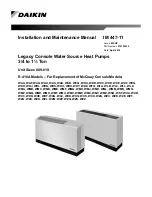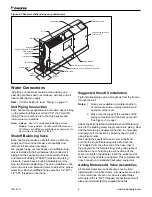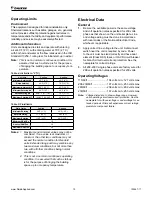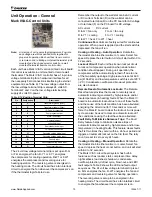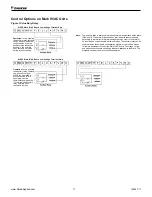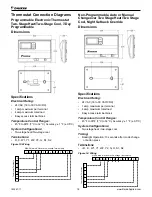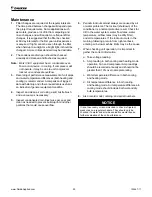
Piping
1.
All units are recommended to be connected to
supply and return piping in a two-pipe reverse return
configuration. A reverse return system is inherently
self-balancing and requires only trim balancing
where multiple quantities of units with different flow
and pressure drop characteristics are connected
to the same loop. A simple way to check for proper
water balance is to take a differential temperature
reading across the water connections when in the
cooling mode. To insure proper water flow, the
differential should be 10˚F to 14˚F (-5˚C to -8˚C).
A direct return system may also be made to work
acceptably, but proper water flow balancing is more
difficult to achieve and maintain.
2.
The piping can be steel, copper or PVC, but must
comply with local codes.
3.
Supply and return runouts are usually connected to
the unit by short lengths of high pressure flexible hose
which are sound attenuators for both unit operating
noise and hydraulic pumping noise. Note: When
using the flex hose connections you must add a 90
degree elbow kit, for making the connection. This
elbow is sweat on one end – female 1/2" FPT on the
other end. One end of the hose should have a swivel
fitting to facilitate removal for service. Hard piping can
also be brought directly to the unit, although it is not
recommended since additional noise
4.
Some flexible hose threaded fittings are supplied
with sealant compound. If not, apply Teflon tape to
assure a tight seal.
5.
Supply and return shutoff valves are required
at each conditioner. The return valve is used for
balancing and should have a “memory stop” so that
it can always be closed off, but can only be re-
opened to the proper position for the flow required.
6.
No unit should be connected to the supply and
return piping until the water system has been
cleaned and flushed completely. After the cleaning
and flushing has taken place, the initial connection
should have all valves wide open in preparation for
water system flushing.
7.
Condensate piping can be steel, copper, or PVC. Each
unit is supplied with a clear vinyl condensate hose.
8.
Units are internally trapped. Copper or PVC condensate
lines can be used. A means of disconnection must be
furnished to facilitate chassis removal.
9.
No point of the drain system may be above the drain
pan of any unit.
10.
Automatic flow control devices must not be installed
prior to system cleaning and flushing.
11.
A high point of the piping system must be vented.
12.
Check local code for the need for electric fittings.
Figure 5: Typical 2-Pipe Reverse Return Configuration
IM 447-11
10 www.DaikinApplied.com
Содержание WAA
Страница 2: ......
Страница 35: ...Notes Comments Form WS CTS 00 01 Rev 4 14 www DaikinApplied com 35 IM 447 11...

